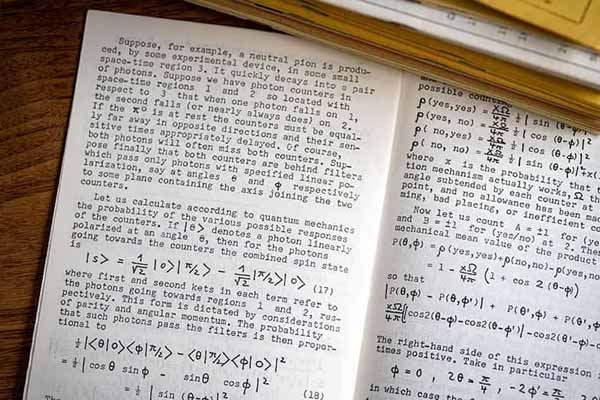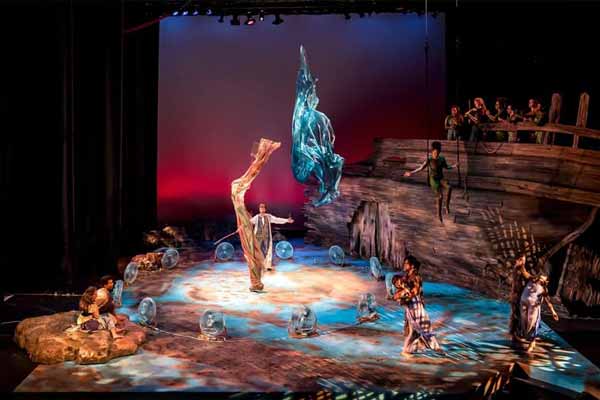In anticipation of the 700th anniversary of the death of Dante Alighieri, and on the Feast of the Annunciation, Pope Francis issued “Splendour of Light Eternal,” an apostolic letter calling Dante “supreme poet” and “prophet of hope and a witness to the innate yearning for the infinite present in the human heart.” The Holy Father added that he wished to join the popes before him in honoring and extolling the poet and “to propose him anew for the consideration of the Church, the great body of the faithful, literary scholars, theologians and artists.”
The University of Notre Dame has long traditions in the research and teaching of Dante and is today considered one of the leading centers in the world for the study of the great Catholic poet.
“I am often asked how Dante is relevant for today. The answer is very simple: Dante confronted a world that was culturally, politically and spiritually in profound crisis.”
When in 1321, the same year he died, Dante completed his “Divine Comedy” — a defining work of Western literature — he could not have anticipated the centuries-long impact of his three-canticle, 100-canto, 14,233-line, hendecasyllabic, terza rima poem. But those closest to his work are not surprised.
Just ask Theodore Cachey, University of Notre Dame professor of Italian and the Ravarino Family Director of Italian and Dante Studies.
Dante Now
In 2020, Cachey was appointed by the Pontifical Council for Culture to serve on the centenary planning committee, which is sponsoring exhibits, conferences, readings and publications on Dante during 2021 and beyond. Among the Dante studies experts appointed to the committee, he is the sole member who is outside of Italy, and, in addition to this service to the Vatican, Cachey and colleagues in Notre Dame’s Center for Italian Studies have planned a full year of commemorative academic and general interest events, including a distinguished lecture series on “Dante in America.” Many of the events have gone virtual due to the pandemic, including an open-source ThinkND series looking at key moments in Dante’s “Inferno.”
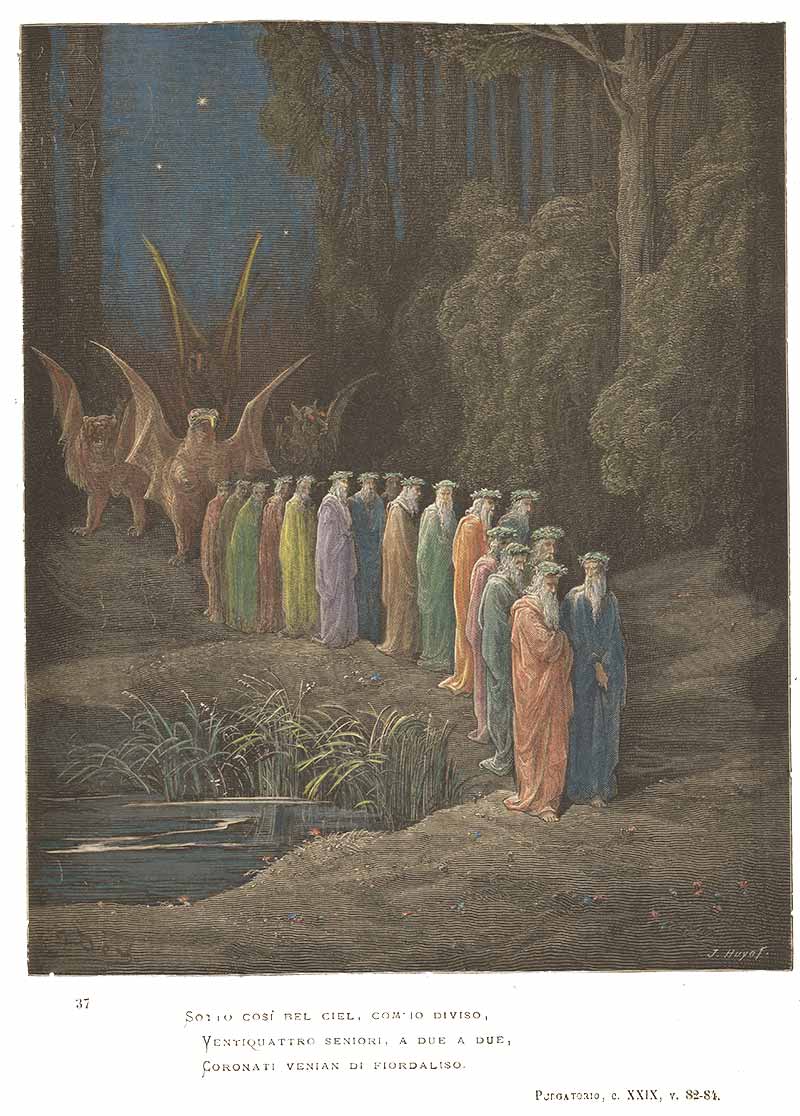
Sotto così bel ciel com'io diviso,
ventiquattro seniori, a due a due,
coronati venien di fiordaliso...
Beneath so fair a sky as I describe
twenty-four elders, two by two,
came crowned with lilies.
Purgatorio XXIX, lines 82-84
—
Copy of the Divine Comedy published by the firm of Edoardo Sonzogno in Milan between 1868-1869. Canto 29 of Purgatorio, with hand-colored engraving by Gustave Doré.
“I am often asked how Dante is relevant for today,” Cachey said. “The answer is very simple: Dante confronted a world that was culturally, politically and spiritually in profound crisis. The world was upside down or out of joint — which ought to sound very familiar to us — and in the ‘Divine Comedy,’ Dante recounts perhaps the most famous midlife crisis in the history of literature.”
In his epic poem, Dante-the-poet narrates himself as Dante-the-pilgrim journeying through the dark wood of sin through Hell, then up Mount Purgatory and on to Paradise.
“His journey and our reading of the poem enable us to reorient ourselves and emerge with a new perspective,” Cachey said. “Dante teaches us how to read his poem, and this process of learning is the point of the exercise.”
‘Read a Canto Every Day.’
This Dantean exercise has enjoyed a long, rich history at Notre Dame — dating back nearly to the University’s founding — and in the subsequent two centuries has grown to encompass such assets as the Devers Family Program in Dante Studies, leading special collections, significant faculty concentrations, an award-winning book series published by the University of Notre Dame Press, Rome-based research and collaborations through Notre Dame’s Rome Global Gateway and academic programming for undergraduate and graduate students that includes an annual year-long Dante course.
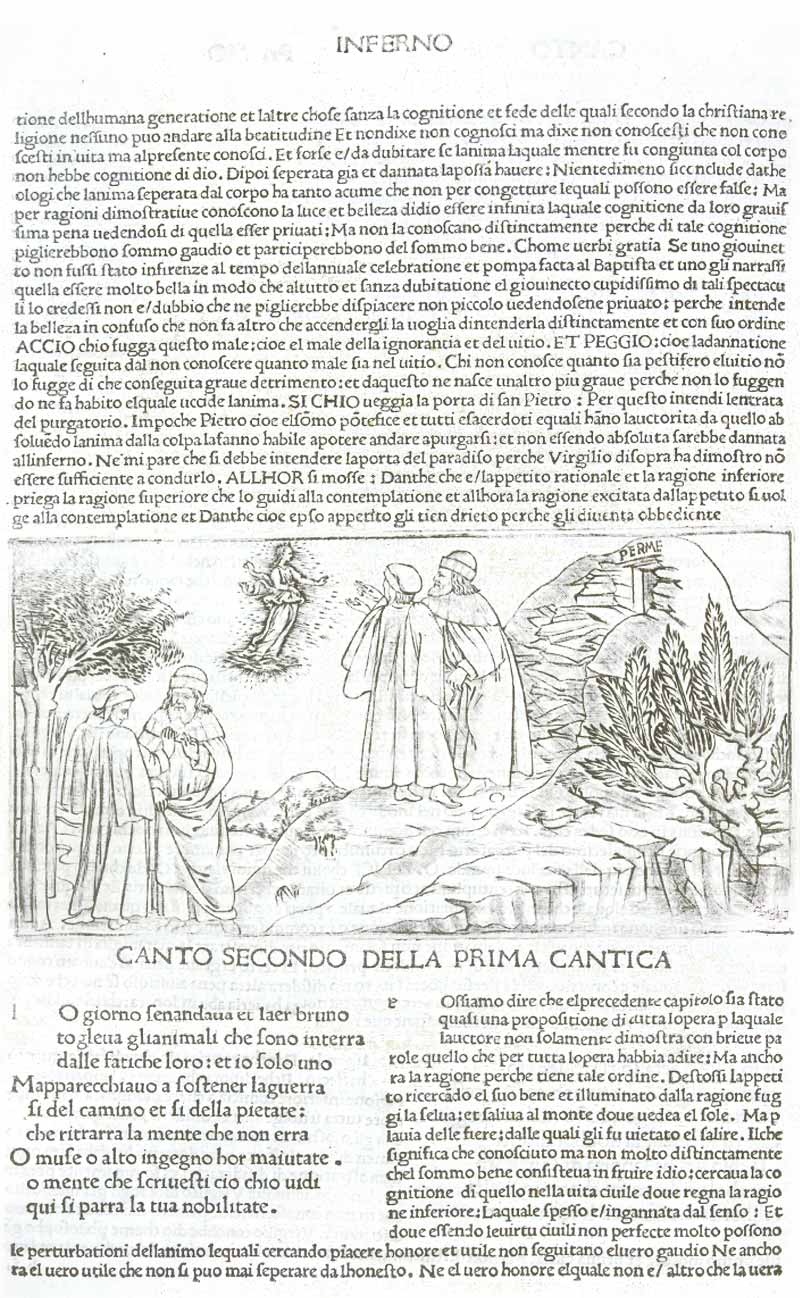
The name that tends to come up first alongside Notre Dame’s history with the “supreme poet” is Rev. John A. Zahm, C.S.C., the first University curator of Dante materials. He served the University as professor, as vice president and in other roles and is principally remembered for advancing the sciences at Notre Dame, championing the cause for the higher education of women and embarking on an expedition to South America with President Theodore Roosevelt. Lesser in the lore on Father Zahm is his lifelong fascination with Dante.
“Father Zahm loved Dante and the ‘Divine Comedy,’” said Tracy Bergstrom, program director and curator for the Notre Dame Zahm Dante Collection. “‘Read a canto every day’ was his philosophy and his practice.”
According to an article by Christian Dupont in the Papers of the Bibliographical Society of America, Father Zahm enrolled as an undergraduate at Notre Dame in 1867 and worked under the tutelage of Rev. Joseph Carrier, C.S.C., then director of the science museum and professor of chemistry and physics. Dupont suggests that Father Zahm’s mentorship by Father Carrier likely instilled not just scientific curiosity, but also the discipline of collecting.
While Father Zahm’s enthusiasm for Dante was well known to those close to him, his formal pursuit of Dante materials began after the Congregation of Holy Cross named him its procurator general in 1896. In 1902, he sailed to Rome and acquired — through many diplomatic interventions of locally based priests and cardinals — the better part of the Dante materials owned by Italian collector Giulio Acquaticci. In total, Father Zahm purchased 48 16th-century volumes of the “Divine Comedy” on that trip, laying an astonishing foundation for what today ranks among the top Dante collections in North America and continues to flourish thanks to an Endowment for Excellence in Dante Studies established in 1995 by the William and Katherine Devers family.
The Inferno - Canto I
The Dark Forest. The Hill of Difficulty. The Panther, the Lion, and the Wolf. Virgil.
Italian
Nel mezzo del cammin di nostra vita
mi ritrovai per una selva oscura,
ché la diritta via era smarrita.
Ahi quanto a dir qual era è cosa dura
esta selva selvaggia e aspra e forte
che nel pensier rinova la paura!
Tant’ è amara che poco è più morte;
ma per trattar del ben ch’i’ vi trovai,
dirò de l’altre cose ch’i’ v’ho scorte.
Io non so ben ridir com’ i’ v’intrai,
tant’ era pien di sonno a quel punto
che la verace via abbandonai.
Ma poi ch’i’ fui al piè d’un colle giunto,
là dove terminava quella valle
che m’avea di paura il cor compunto,
guardai in alto e vidi le sue spalle
vestite già de’ raggi del pianeta
che mena dritto altrui per ogne calle.
Allor fu la paura un poco queta,
che nel lago del cor m’era durata
la notte ch’i’ passai con tanta pieta.
E come quei che con lena affannata,
uscito fuor del pelago a la riva,
si volge a l’acqua perigliosa e guata,
così l’animo mio, ch’ancor fuggiva,
si volse a retro a rimirar lo passo
che non lasciò già mai persona viva.
Poi ch’èi posato un poco il corpo lasso,
ripresi via per la piaggia diserta,
sì che ’l piè fermo sempre era ’l più basso.
English
Midway upon the journey of our life
I found myself within a forest dark,
For the straightforward pathway had been lost.
Ah me! how hard a thing it is to say
What was this forest savage, rough, and stern,
Which in the very thought renews the fear.
So bitter is it, death is little more;
But of the good to treat, which there I found,
Speak will I of the other things I saw there.
I cannot well repeat how there I entered,
So full was I of slumber at the moment
In which I had abandoned the true way.
But after I had reached a mountain's foot,
At that point where the valley terminated,
Which had with consternation pierced my heart,
Upward I looked, and I beheld its shoulders,
Vested already with that planet's rays
Which leadeth others right by every road.
Then was the fear a little quieted
That in my heart's lake had endured throughout
The night, which I had passed so piteously.
And even as he, who, with distressful breath,
Forth issued from the sea upon the shore,
Turns to the water perilous and gazes;
So did my soul, that still was fleeing onward,
Turn itself back to re-behold the pass
Which never yet a living person left.
After my weary body I had rested,
The way resumed I on the desert slope,
So that the firm foot ever was the lower.
According to Bergstrom, Father Zahm’s zeal was specific and personal; however, American interest in Dante was generally very high at this time. In 1867, Henry Wadsworth Longfellow had published the first American translation of Dante’s “Divine Comedy” at Harvard. In the Notre Dame lecture series “Dante in America” examining Dante’s impact on American culture, Laura Dassow Walls, the William P. and Hazel B. White Professor of English at Notre Dame, explained how the poet’s influence on the transcendentalists was pervasive.
Dupont notes that the majority of Father Zahm’s will, handwritten in 1917, is concerned with the future of the Dante materials. The priest-collector-scientist requested that the majority of his estate be used to preserve and enlarge the collection, “for it has always been my desire to see my alma mater the possessor of the most valuable Dante collection in existence.” He also expressed his wish that a Dante chair be established at Notre Dame.
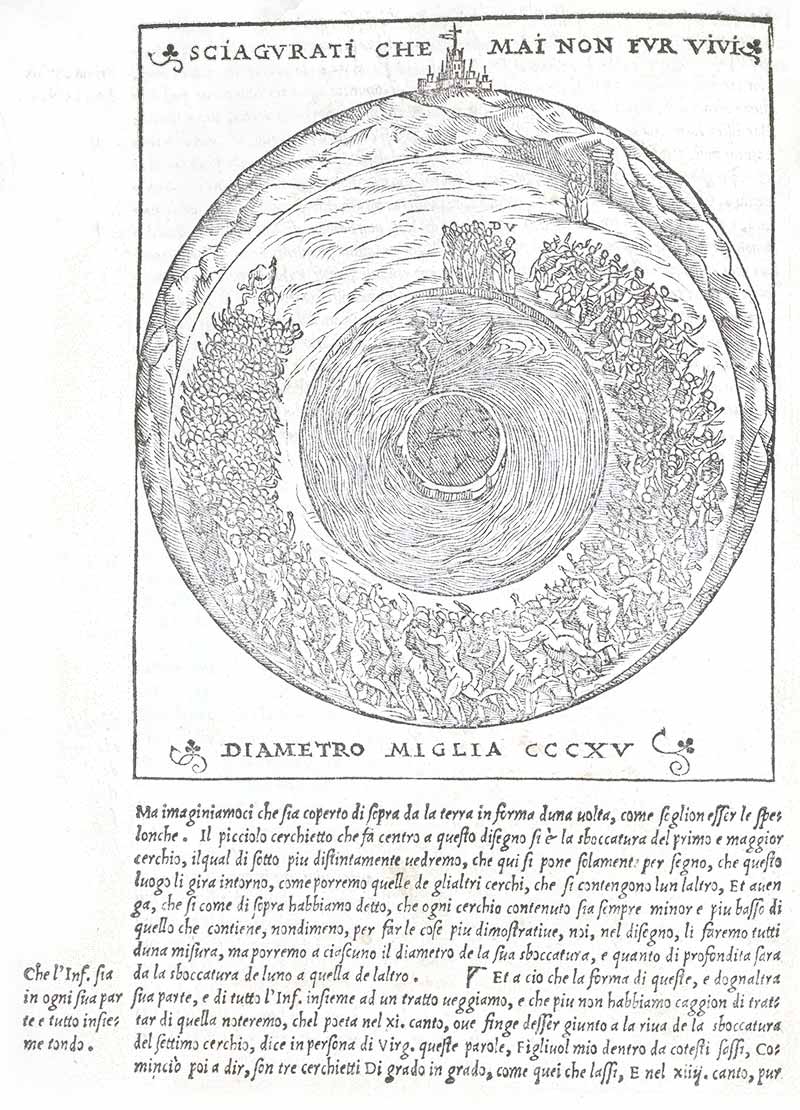
Father Zahm would be pleased to know the collection has grown to include thousands of copies of the “Divine Comedy,” dating from 1477 to the present. Many contain commentaries to the poem, which serve as a kind of history to what people reading Dante in different eras were responding to in the text. In addition to stunning illustrated editions by Salvador Dalí, Tom Phillips and others, there are 20th-century trading cards and other Dantean pop cultural material. The collection is set to expand in the coming years to support even more scholarly work and undergraduate engagement.
“Scholars from around the world come to Notre Dame to study the Zahm Dante collection,” Bergstrom said. “It’s also valued on campus as a teaching collection, one that really hooks students in. The firsthand experience exposes students to the wonder of the poem and inspires their own approach to undertaking significant, original scholarship.”
In Medias Res
Zygmunt Barański, the R. L. Canala Professor of Romance Languages and Literatures, will retire this year after 45 years of teaching Dante in several different countries. He came to Notre Dame in 2011 after nine years as the Serena Professor of Italian at the University of Cambridge.
“People find him [Dante] fascinating because he was an extraordinarily experimental creative writer, challenging the way in which literature had evolved since the ancient world, and the majority of students find something that interests them — often something very personal.”
Part of what attracted him to Notre Dame, both as a visiting professor in the 1990s and later as permanent endowed faculty, was wanting to teach a Catholic poet within a Catholic cultural context. “I am not a person of faith, and I always tell my students this straight out,” Barański said. “But if you want to be a Dantist, especially in the English-speaking world, Notre Dame is the place to do it.”
He noted Notre Dame’s unique faculty strength in Dante and medieval and Renaissance Italian studies, as well as many successful graduate and postdoctoral students throughout the world, although Christian Moevs, associate professor of Italian and fellow Dantist, will join Barański in retiring in spring 2021. New appointments will be essential to keep Notre Dame’s historic prominence and current momentum in Dante studies.
Reflecting on the course of his teaching career, Barański said: “I don’t think I’ve ever really changed the way I teach Dante; people find him fascinating because he was an extraordinarily experimental creative writer, challenging the way in which literature had evolved since the ancient world, and the majority of students find something that interests them — often something very personal.”
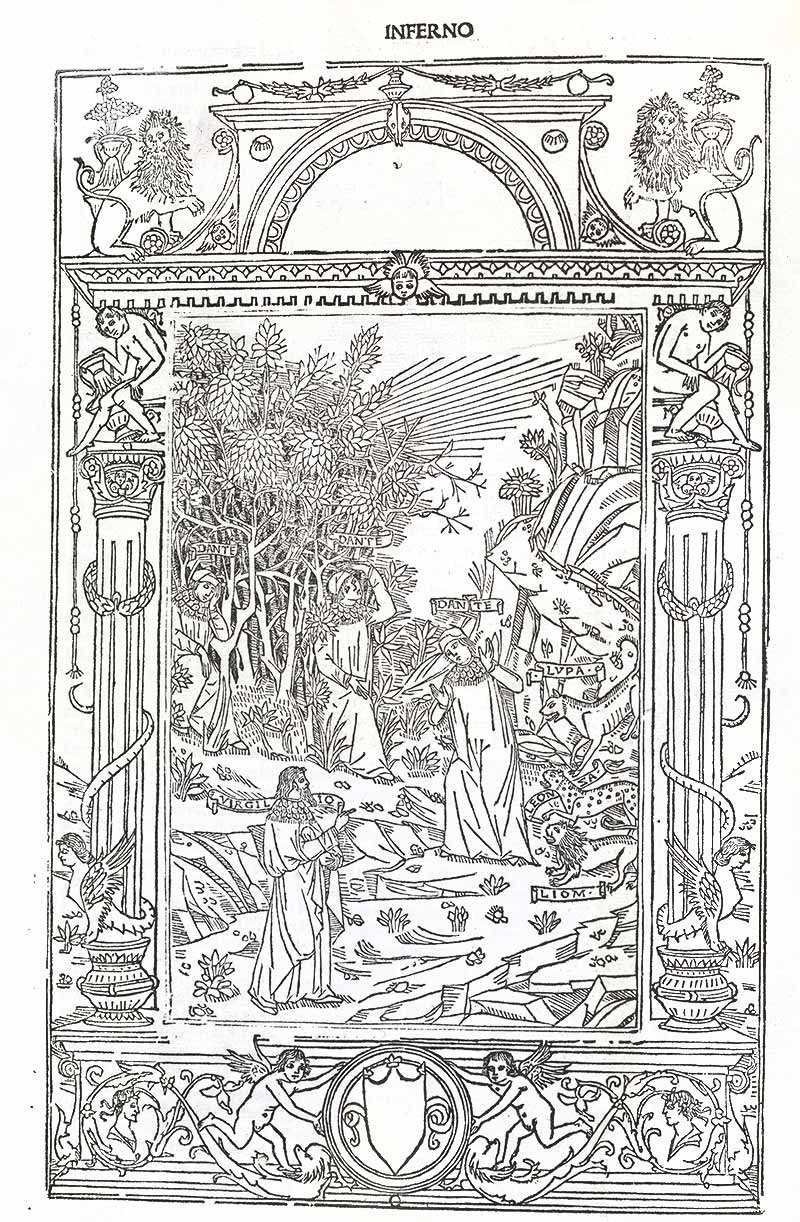
There is something in Dante for everyone, he said, because Dante himself was the consummate cultural commentator of his day, and was curious about everything — from politics, culture and theology to barrel makers in Florence.
Retirement does not seem likely to slow the pace of Barański’s research. He is currently studying a section of “Paradiso” that takes place in Dante’s so-called Heaven of the Fixed Stars. “Of all the heavens before arriving in Heaven, Dante dedicates the most space and cantos to this one — why?” he said. “You never get bored with Dante, and he compresses so much into one line. I just wrote a 20-page piece on one verse from ‘Inferno’ 34: ‘I didn’t die, and I didn’t remain alive.’”
In an interview with Bibliotheca Dantesca, Barański’s colleague Cachey recounts the turning point that led him down the Dante path. He was a high school student on the south side of Chicago when his friend gave him a 1909 Italian edition of the “Divine Comedy” he had found at a used bookstore. Cachey later enrolled as an undergraduate at Northwestern University, where he majored in English with a second major in Italian.
“I think I can truthfully say I learned Italian in order to read Dante,” Cachey said. “And, of course, this is something that is still true today of many undergraduate students at colleges and universities across North America and at Notre Dame.”

